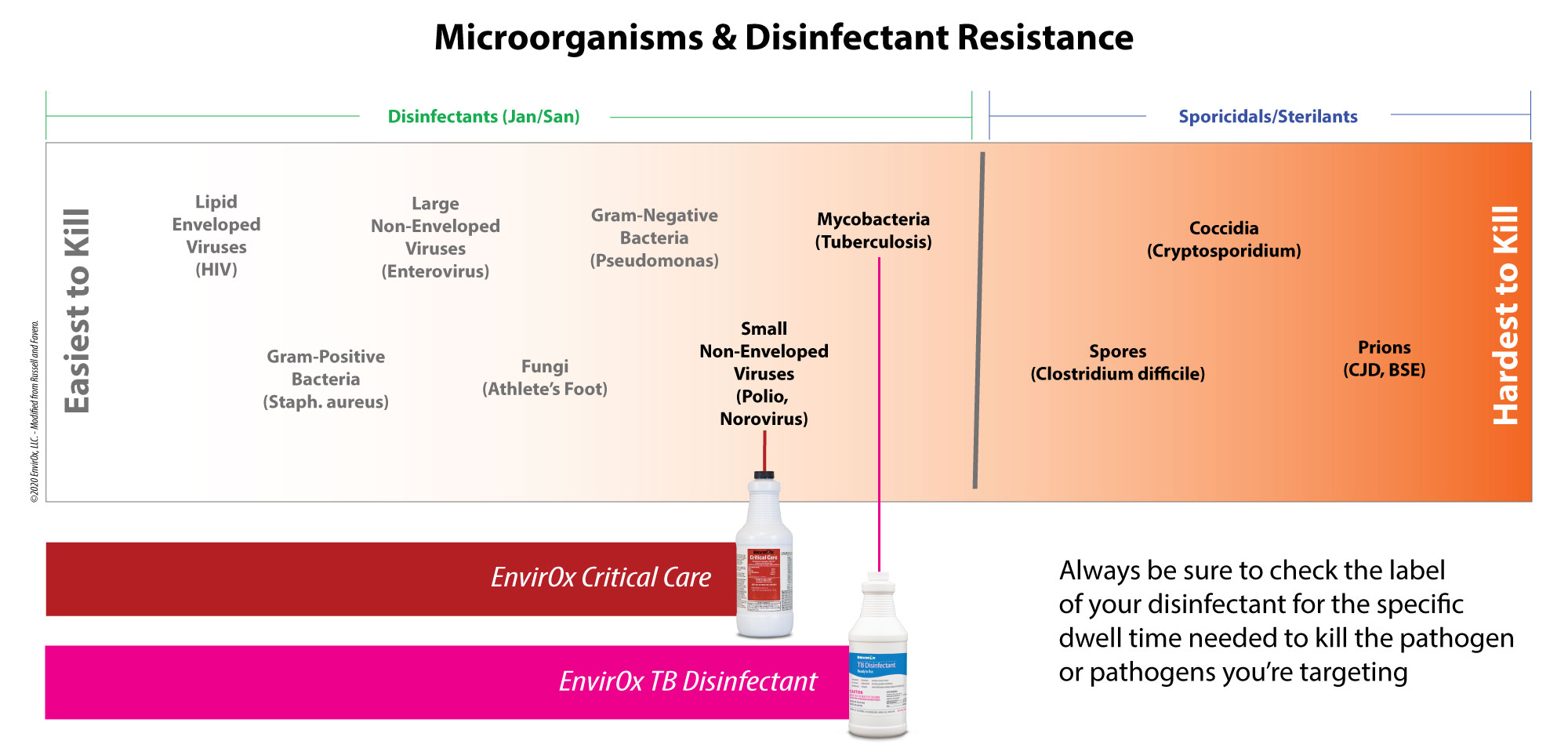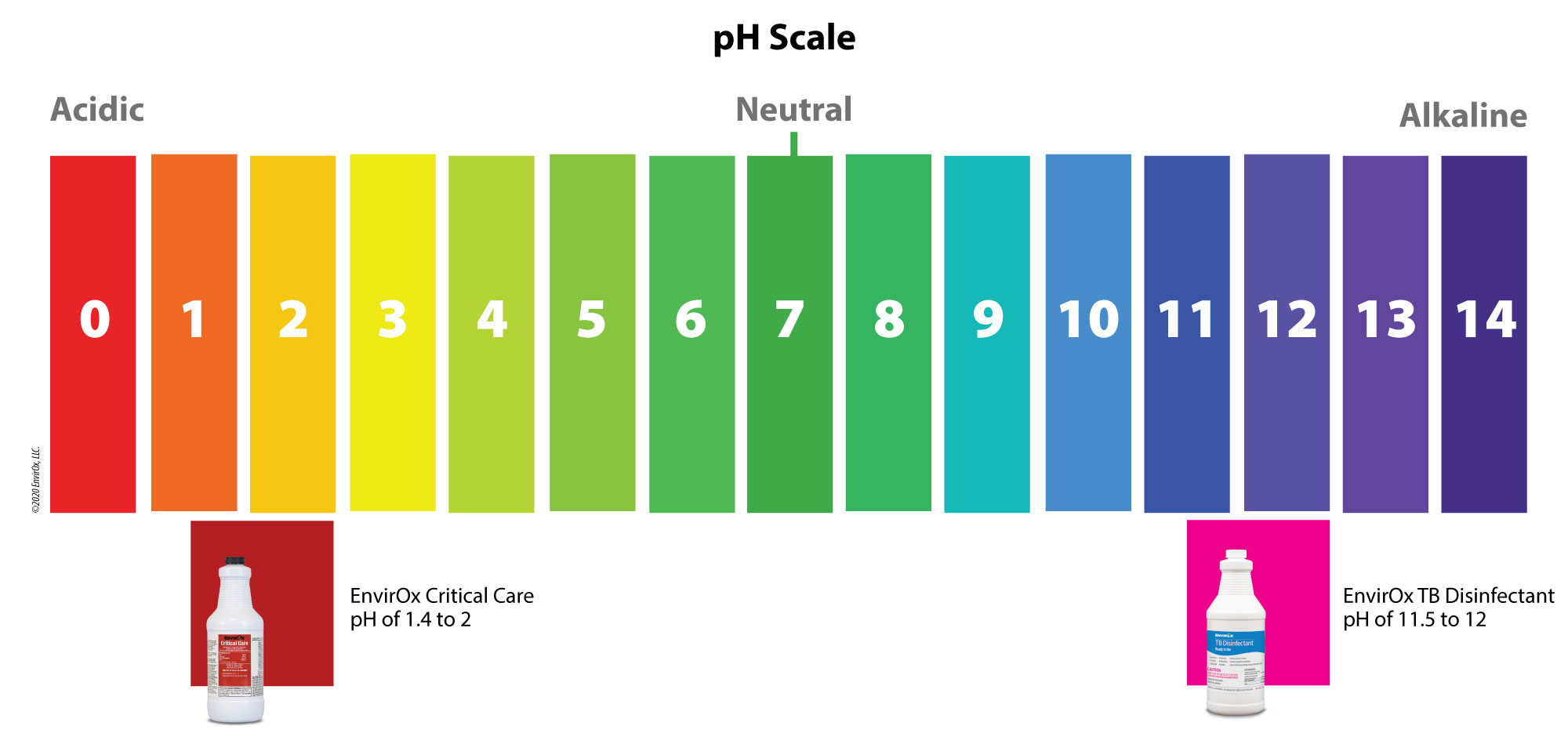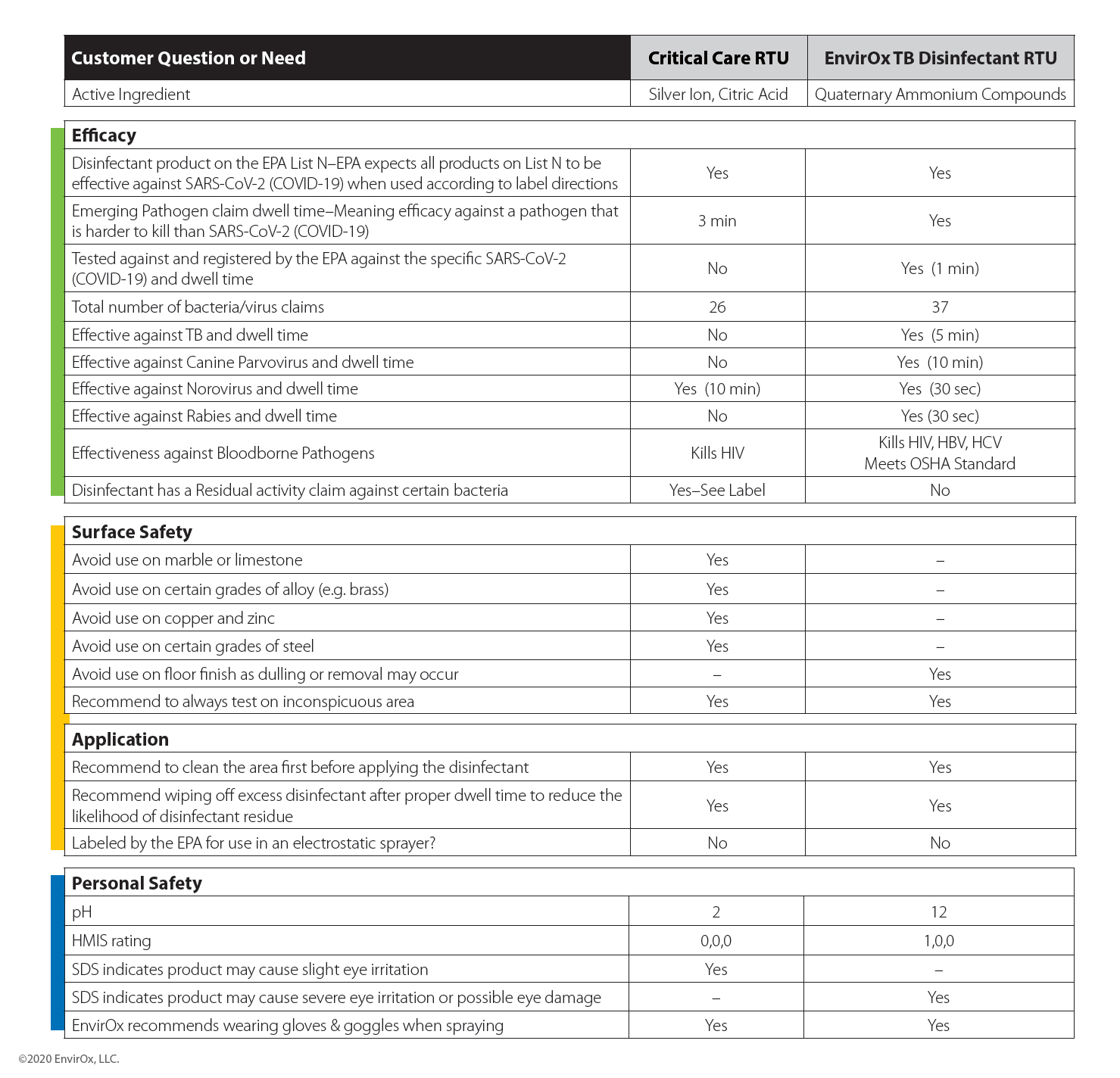Disinfectants have fast become an everyday part of life for everyone, but most especially cleaning staff. Across the nation, facilities face an array of products they didn't have to deal with before. We recently introduced our EnvirOx TB Disinfectant, which joins Critical Care as another RTU disinfectant in our line-up. So that got us thinking. How do people know which one to choose? How do they know which one is right for them? We are here to help you figure out which RTU disinfectant is suitable for your needs, no matter what products you're evaluating.
Before we jump in, we need to recognize that disinfectants are formulated to kill living organisms such as pathogens. Pathogens are broadly defined as any organism that can produce disease. Disinfectants are designed to kill living organisms, but of course, they can't differentiate between pathogens and other living organisms. Since we are living organisms, it makes sense we need to use caution in the use and amounts of disinfectants we expose our cleaning staff and building occupants to.
Wait, What About Concentrates?
At EnvirOx, we believe concentrates are a great solution. You'll see that we offer concentrates and hyper-concentrates across all of our multi-purpose cleaning technologies. Ideally, you’ll pair whatever disinfectant you choose with one of our versatile, low-residue cleaners. So why aren't we talking about concentrated disinfectants right now? The supply chain for disinfectant concentrates is experiencing global shortages, and it's unlikely that it will settle down until late 2021. You need disinfectants now.
What are the Advantages of RTU Disinfectants?
- They're great if you have specific pathogens you need to kill
- As we'll see, disinfectants come in a wide variety of technologies. Unless you're in a healthcare facility, you're likely targeting specific pathogens. For most non-healthcare related facilities, a disinfectant with a TB claim represents the most aggressive formula required. There are other factors such as dwell time and safety. This is simply a rule of thumb to frame our discussion.
- They encourage targeted practical disinfection.
- Disinfectants are a must to combat COVID-19. Of course, there are many pathogens and fungi still out there constantly challenging building occupants' health. Slathering disinfectant all over everything is not a great short-term plan, let alone a long-term one. Disinfectants carry varying degrees of acute and chronic effects that must be considered. We disinfect critical touchpoints to focus our efforts and not spread harmful disinfectants needlessly in a facility.
- Using RTU disinfectants can help encourage good disinfection habits, especially with staff who are not used to using them, because they don't seem as "endless" as concentrated products. It's a small but critical bit of psychology.
- The use of RTU disinfectants does not allow for the mopping of floors with disinfectant. Most of us have experienced “sticky floors”. This is caused by disinfectant overuse coupled with poor mopping procedures.
Five Questions
Let's start with five questions to consider when you’re choosing a disinfectant. We have a handy Needs Analysis worksheet you can download to support your process.
Q. In addition to SARS-CoV-2 (COVID-19), what other KEY organisms does your disinfectant need to kill?
While it seems all the attention today is on COVID-19, there are other pathogens we need to be aware of. Simple things like cold and flu to more complex organisms like Norovirus and TB. Pathogens can be grouped by how difficult they are to kill. As you move from the left to the right, the harder the pathogen is to kill, and a more powerful disinfectant is needed.

It's tempting to think, "give me the strongest thing you've got!" But this can be the equivalent of using a nuclear bomb to kill a housefly when a fly swatter would be much more effective and less destructive! There are other factors to consider, including cost and safety. So, it's a good idea to have a realistic and informed view of what you need to eliminate when you disinfect.
Q. In general, what do you consider is a realistic RTU disinfectant dwell time using your current disinfection procedures?
We have all seen this scenario. Someone cleaning a table with a spray disinfectant. They spray the disinfectant on the table and then immediately wipe the table dry. In this scenario, there was no dwell time, and it is unlikely the disinfectant had time to work.
Different disinfectant technologies come with different "dwell" times, depending on what pathogen you're trying to kill. Always consult the disinfectant's instructions for the exact timing. Depending on your facility size, staffing, and training, it's good to consider how much dwell time you can allow on an ongoing basis. A retailer that wants to disinfect a scanner between every patron's visit requires a much quicker dwell time than a custodian who is disinfecting a bathroom a few times a day.
Q. Are any of the surfaces you will disinfect natural stone or metal alloys? (e.g., marble, brass) Any damage issues in the past?
Whenever you try any new product in your facility for the first time, we recommend that you test it on the surfaces you're going to clean. Choose a spot that isn't very visible. There are many alloys and materials on the market these days being used for everything from countertops to doorknobs to flooring. Companies can't test their product on every possible surface. However, one factor you can look at is the pH of the product.
A pH of 1 is Acidic
A pH of 7 is Neutral
A pH of 14 is Alkaline

Whether a disinfectant is more acidic or more alkaline doesn't make it "good" or "bad." As a rule, acidic products may harm some metal alloys along with types of metals to include copper and zinc. Acidic products may harm marble or limestone surfaces. High alkaline products may remove the finish from floors and furniture. Disinfectants can have long-term effects on surfaces. This provides the basis for the industry best practice of testing products on an inconspicuous spot and closely following the label directions.
Q. By their very nature, all disinfectants need to be handled with care (e.g., wearing goggles and gloves when spraying product). What is the common practice in your facility?
Recall we need to recognize that disinfectants are formulated to kill living organisms or pathogens. All disinfectants require additional caution and worker training to ensure the safe, proper disinfection of surfaces.
Some things to consider for this question: What access to protective equipment does your staff have? What can you make available as needed? How much experience does your team have handling disinfectants? Has your staff embraced past training? How quickly can they be trained? When are you cleaning? Is it happening at night in unoccupied buildings or during the day in high-traffic areas? It's good to be as practical as possible about who uses the disinfectant and how much exposure they'll have to it.
Let's return to the retail example above. It's reasonable to expect a custodian to be able to use a potentially more toxic disinfectant safely than a part-time retail worker who is more used to ringing up items for a customer than cleaning or disinfecting. But even with experienced cleaning professionals, you should consider how quickly they have to clean and who occupies your facilities.
Very generally, the more effective a disinfectant is in killing harder-to-kill pathogens, the more potential risks it poses to cleaning workers and occupants. However, always remember to check the SDS (Safety Data Sheet) to assess the potential risks of a specific disinfectant. You can mitigate these risks through proper protective gear, training, and processes. But they should still be factored in when selecting a disinfectant.
So, What RTU Disinfectant Should I Choose?
Now that we've considered the questions above, it's time to select the right disinfectant. While we can't show you all the options on the market, we have made a chart illustrating the differences between the two RTU disinfectants we offer, Critical Care and TB Disinfectant. The chart below is available to download as part of our interactive needs analysis sheet.

Points to Remember
There are many choices in disinfectants available. We hope this provides some ideas on things to consider. Regardless of the disinfectant, the Centers for Disease Control (CDC) recommends the following:
- The surface needs to be clean of soils before the disinfectant is applied. Disinfectants are more effective on a clean surface allowing the disinfectant to come in contact with the pathogens.
- Proper dwell or contact time is required to allow the disinfectant to destroy the pathogen. The surface needs to remain wet from the disinfect for the required dwell time.
- Follow the label instructions carefully for the disinfectant you choose to use.
Should you have additional questions, we welcome your call. We are here to help as our mission to help deliver a clean, healthy environment for your building occupants and cleaning professionals.